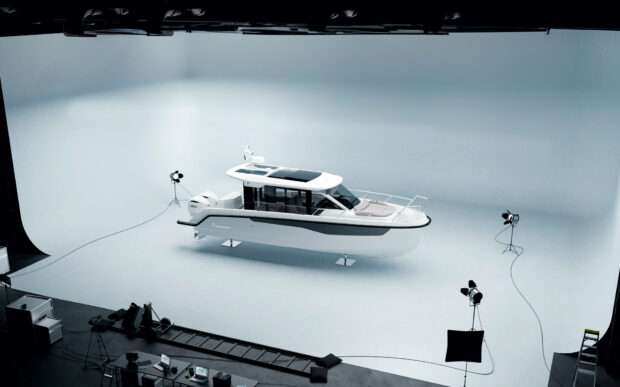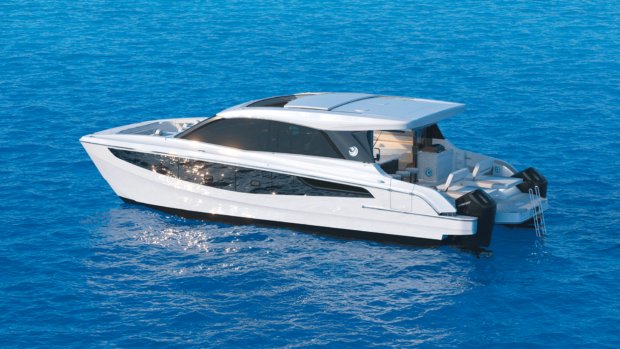Fisherman presumed drowned, crew confined to naval base pending investigation
This is the latest press release from the Earthrace team. The boat was trying to break the round the world speed record at the time of the collision:
At 00:30 local time, on the 17th of March 2007, Earthrace was involved in a collision with a small fibreglass fishing skiff off the coast of Guatemala, one fisherman is still lost, presumably drowned, and a second fisherman seriously injured and in the hospital.
Earthrace was en-route from Panama to Acapulco, on the second leg of her attempt to set a new world record for a powerboat to circumnavigate the globe on Biodiesel. She left Balboa Yacht Club in Panama on the evening of the 16th of March, but early in the morning of the 17th, a heat exchanger on the starboard engine developed a hairline crack that leaked increasing amounts of oil into the bilge. The crew attempted to repair the crack using epoxy liquid metal, but it failed to stem the oil flow sufficiently to allow continuous engine operation. The decision was made to voyage the remainder of the leg to Acapulco on just the port engine, and at reduced load, limiting speeds to around 16 knots.
At 23:58 on the 17th of March, Earthrace Captain Pete Bethune awoke Anthony Distefano, the Engineer aboard Earthrace, to commence his two-hour watch. At 00:15, now the 18th of March, Ryan Heron, who had been struggling to sleep, got up from his pipe cot and had a short chat with Anthony, before returning to bed.
At 00:30, Distefano spotted a small white and red flashing light directly ahead. According to maritime law, flashing lights are to be used as navigational aids, marking things such as channels. Boats are marked with solid white, red and green lights only. Distefano, assumed the flashing light was on some form of beacon, and was checking the GPS system to locate which beacon he was looking at. The small size of the bulb gave him the impression the light was still considerable distance away. A few seconds later, Earthrace collided with a small fiberglass fishing vessel, approximately 5m in length.
Immediately following the accident, three fishermen were visible off the stern of Earthrace. Carlos Contreras Cruz, the youngest of them, clambered onto the transom step of Earthrace and collapsed. 51-year-old Pedro Salazan Gonzalez remained struggling between the hull of the fishing vessel and the transom, and was also gasping for air. Earthrace Skipper Pete Bethune jumped in and helped push the man up to the transom step, while Earthrace Engineer Anthony Distefano, pulled him from above. Distefano had seen a third man in the water minutes earlier and had thrown him a life buoy to cling to. Bethune swam over to the area but failed to locate him. After 15 minutes of searching from the water, the crew decided to start the port engine and circle the area to look for the third fisherman.
A number of Mayday calls were placed, initially on Channel 16, then several other frequencies, in an effort to get assistance with the search. Requests were made in both English and Spanish.
Earthrace scoured the area for ninety minutes, before driving over to 3 boats fishing nearby, and asking for assistance in the search. The fishermen were unwilling to help. Earthrace returned to the collision area and resumed the search for several more hours.
By now it was evident that the port propeller or driveshaft of Earthrace had been severely damaged in the collision. Engine speed could not be taken over 800rpm, without inducing excessive vibrations. With the starboard engine already out through the damaged heat exchanger, Earthrace now had a maximum speed of just 5 knots.
On being rescued, Gonzales had complained of severe pains in his stomach and chest, and David Stark, the trained doctor aboard Earthrace had been monitoring his condition. The blood pressure started at 104 / 60, but had steadily decreased as time passed. A second visit was made over to the local fishing vessels, requesting them to take Gaonzalez, along with Dr. Stark, to a hospital where the man could receive full treatment. The local fishermen again refused to help, despite being offered US$300 in cash, which were all the funds the crew had at the time.
At 05:20, the decision was made to commence the voyage to Puerto Quetzal, some 40 nautical miles South. The team was hoping that one of the local boats, or perhaps a military vessel, could be encouraged to meet Earthrace part way, and then take the Gonzalez on to port at reasonable speed. At 5 knots, it was going to take Earthrace 8 hours to reach port, by which time the crew believed the man would be dead.
By now, calls were increasingly made to several organizations, including the US Coastguard, in an effort to get local support for a medical evacuation. Calls were also placed to the US embassy in Guatemala.
Gonzalez blood pressure which had started at 104 / 60, continued to decline, so the decision was made to administer saline solution intravenously. On reaching 70 / 60 the crew believed the patient was dying before their eyes, and placed several more urgent phone calls saying in effect ” this patient will die here if we do not have him evacuated”. Meanwhile Earthrace continued its painfully slow voyage towards Puerto Quetzal.
At 6:35am, crew starts the starboard engine in an effort to get more speed. The engine oil starts to froth from water it is contaminated with, and within minutes much of the oil is lost into the bilge. The starboard engine was therefore turned off.
Bethune and Distefano then go into the water with masks to inspect for driveline damage. Three of the four blades on the port propeller were bent. Using a monkey wrench they bent the tips as straight as they could, but with only minimal impact. This allows boat speed to be increased to 7 knots.
At 6:56am, an email is received informing Earthrace that the US Coastguard has made contact with Guatemalan authorities, but that no boats are immediately available to help with the evacuation. At 07:20 an email is received saying a US Lt. Colonel has been in contact with the Guatemalan Coastguard, and that they are en-route to provide assistance. Then at 07:23, an email arrives saying a US Navy Vessel has left the Port of San Jose heading for Earthrace.
By now, over 2.5 litres of saline solution had been administered to Gonzalez, and he had started to make gradual improvements, despite suffering continual and severe pains in his chest and abdomen.
At 09:40 am, Earthrace crew spot a Naval Vessel heading towards them and make contact via VHF Channel 16. At 10:05am, the Vessel arrives alongside, as does the Dolphin I, a small 15ft fishing boat. The patient is transferred to the Dolphin I, which then left urgently to get the man to hospital. Ironically, the crew aboard Dolphin I was the same that had refused to provide assistance the night before.
Gonzalez was taken to Hospital Privado Genesis near Guatemala City, and treated by Dr. Carlos Enrique Robles Mendez. He was operated on, and found to have a perforated intestine, a perforated stomach, and a fractured sternum. He is now in a stable condition and expected to recover. Medical opinion is that the saline solution administered to the patient saved his life.
Earthrace was escorted into Puerto Quetzal and placed under military guard, with the crew confined to the boat and naval base, pending an investigation. The crew of Earthrace is all safe and is being treated well by the local authorities. Given that this matter is now the subject of an official investigation, Earthrace crew has been advised to make no further comment at this time.









